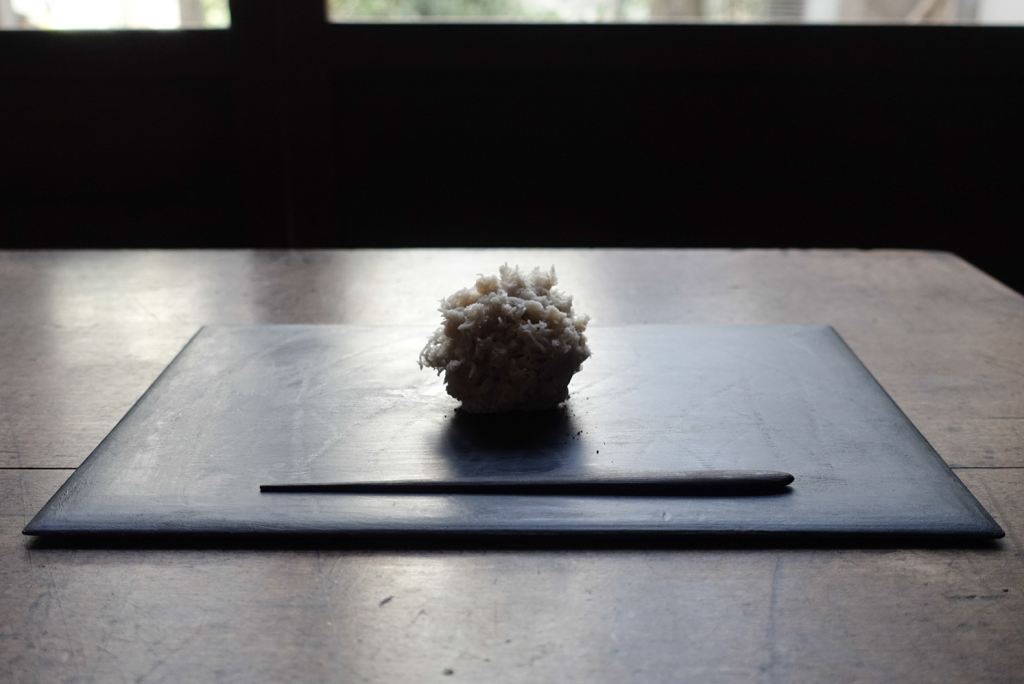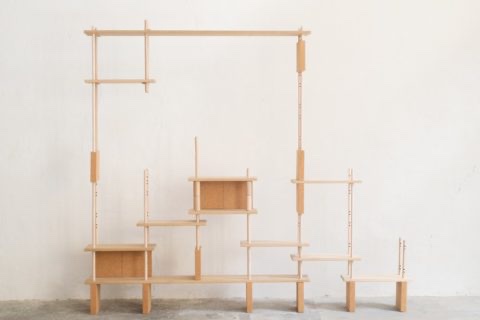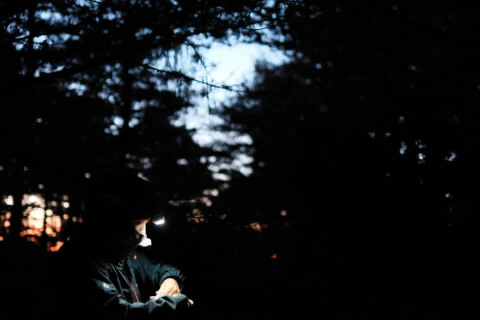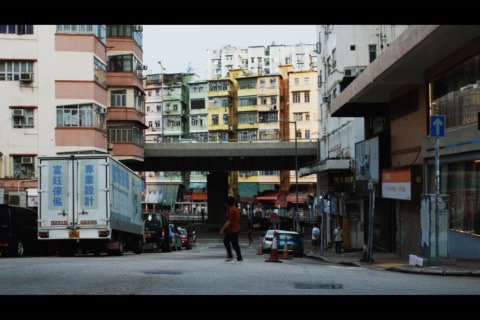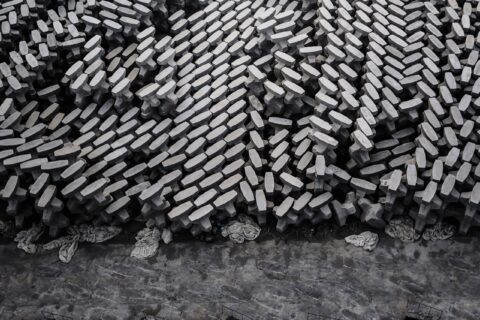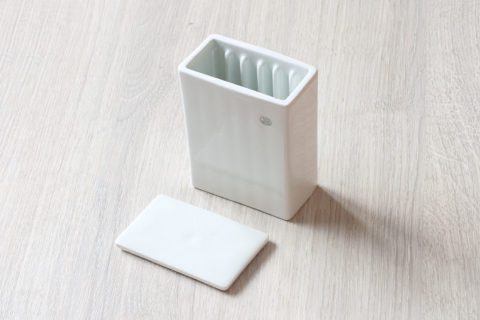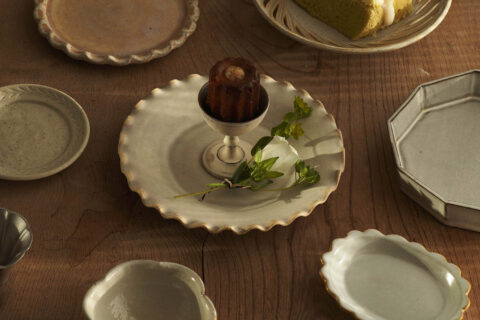
我用竹叉子仔細地將和菓子切開,白中透紫的菓子在嘴裡被舌頭輕輕一推就化開了。咸的?雖然和菓子師杉山早陽子在端上來時已跟我說過,這菓子不甜,卻仍被意想不到的咸香嚇了一跳。此時舌頭更感到輕微的麻,一陣橘子的香氣在口腔擴散。
Using a bamboo fork to carefully cut up a small piece of wagashi. This piece of purple-ish white confectionery just effortlessly melted in my mouth, and it tasted… savoury! Although Sayoko Shugiyama, the wagashi maker, already told me that this is not sweet, I didn’t imagine it to be so savoury. I was totally surprised by the saltiness and the slightly tongue-tingling bite. After all these unexpected attacks of taste, my mouth was filled with a fragrance of tangerine.
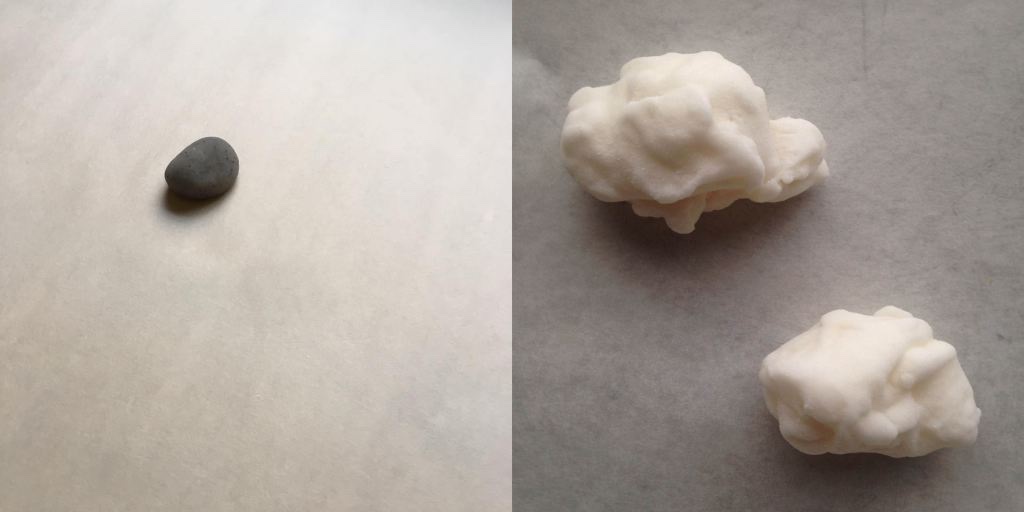
內裡加了外國的山椒啊。」杉山早陽子看著我驚訝的臉笑說。「其實和菓子不一定是甜的啊,於室町時代砂糖自中國傳入以前,大多數都是咸的。這個的原材料是把山芋、紫薯放進上湯裡熬煮而成的。」
說到和菓子,我腦中總是浮現起櫻花的影像,不是在頭上綻放燦爛的那種,而是安靜躺在碟子上的,花瓣肥厚,奪目粉紅的外面之下,是甜得牙齒發軟的紅豆泥。杉山早陽子給我造的這一顆,結結實實地將我對和菓子的印象打破。她熱愛和菓子,卻沒被和菓子的約定俗成所束縛。大部份和菓子以風月花鳥談季節與自然,杉山早陽子著眼蒲公英、鑛石與黃昏天色等等與我們更親近的事物。大部份和菓子都藏在暖簾後,收在被刷得發亮的玻璃展示櫃裡,她卻寧願它們是更親民的,甚至儲在你的櫥櫃內,在你興頭來時,跟紅茶與咖啡一起點綴你的下午。
Looking at my astonished expression, Shugiyama laughed and said, “imported peppercorn was added to this piece of wagashi. Wagashi is not necessarily sweet. Before sugar was imported from China during the Muromachi period, wagashi were usually savoury. The one you had was made from yam and purple potato cooked with broth.”
Wagashi in my mind are usually in the shape of cherry blossom. The only difference is that they do not hang from a tree, but lie elegantly on a plate, as if cutting open its gorgeous pink fat pedals would reveal the extravagantly sweet red bean paste. My presumption was completely challenged by Shugiyama’s wagashi. Her fondness for wagashi did not confine her to the common framework of the delicacy. Most of the wagashi makers try to express their affection for the four seasons and nature using the themes of beautiful nature, flowers and birds. Shugiyama has a unique interest in shapes that are closer to everyday life, like dandelions, ore and sunset. Rather than delicately displaying wagashi in a spotless glass box behind a split curtain, Shugiyama believes wagashi should be less out of reach. It can well be a more relaxed delicacy that can easily go with an afternoon tea or coffee.
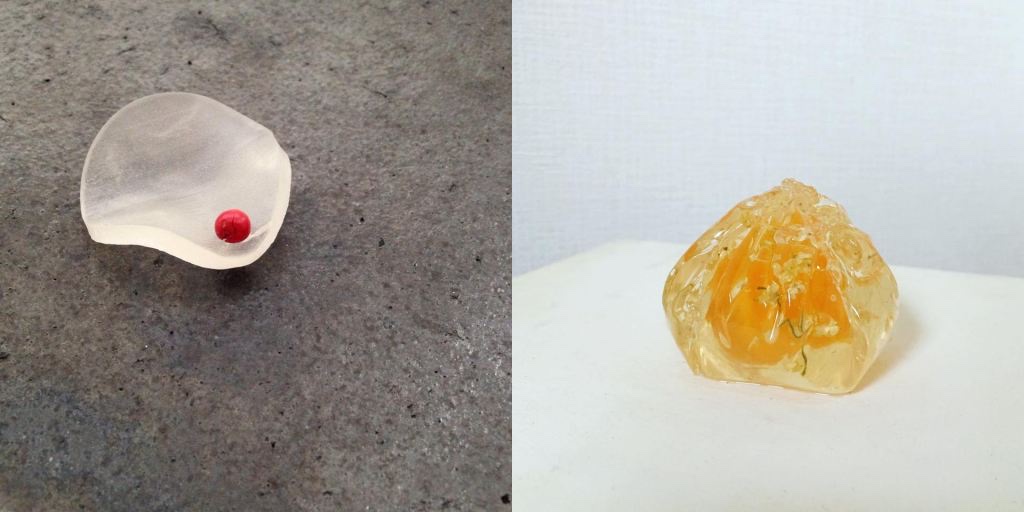
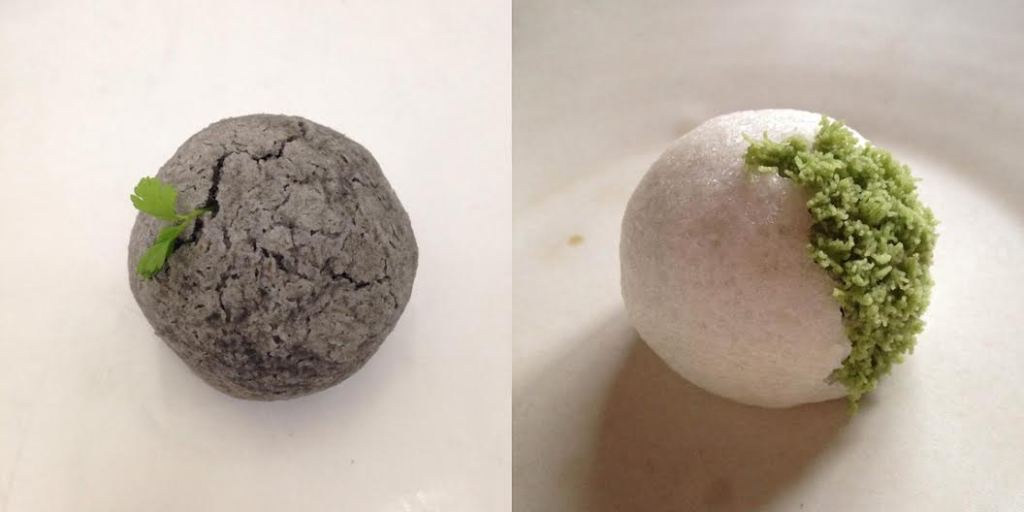
(R:Ron, S: 杉山早陽子)
R:杉山小姐是在甚麼時候開始對和菓子產生興趣的呢?
S:我在大學時是主修攝影的,但卻沒想過要當攝影師,那時一直在探索自己將來想要做的事。因為在京都生活,有很多機會接觸到和菓子。我本來便愛逛和菓子店,後來我讀到《和の菓子》一書,裡面呈現和菓子的手法,跟我們平常接觸到的非常不同。和菓子被置在白色的背景之上,每一個都配上相關的故事,就如同藝術品一樣,我被書中的世界觀深深吸引,漸漸希望以和菓子為媒介,表達自己的想法。
R:杉山小姐曾在和菓子店上班,是在那時學會製作和菓子的技術嗎?
S:我那時負責的只是店頭販賣而已,兩三年後,為了能參與製作,我轉職到另一間公司,可能在新公司仍無法如願。工作了一段時間後我還是拋不開親手造和菓子的念頭,於是邊觀察邊研究,完成一件作品後便跟工場的和菓子師分享,探問意見,在反覆嘗試之中一點點地學習。雖然現在說自己是和菓子師,但好像也不大貼切,始終在我來說,和菓子只是一個表達的媒介而已。
(R:Ron, S: Sayoko Shugiyama)
R: When did you first become interested in wagashi?
S: I majored in photography in university. Since I didn’t think of becoming a photographer, I tried exploring different possibilities for my life. Living in Kyoto, my life is closely connected to wagashi. Wandering in wagashi stores is one of my habits after all. The book Wagashi changed my impression towards wagashi. In this book, pieces of wagashi are placed in front of a white backdrop, and each photo is accompanied by a story. Such artistic presentation strongly drew my attention. I began to wish using wagashi as a medium to express myself.
R: Did you learn the technique of making wagashi when working in a wagashi store?
S: I was only responsible for sales related task back then. I switched to another company in the hope of learning the technique of making wagashi, but luck didn’t come to me. The crave for making my own wagashi continued to grow in my mind, therefore I spent great effort in observing and researching. I sought the wagashi makers’ comment after every attempt of making wagashi, that was how I learnt bit by bit through repeated trial. I am a wagashi maker, but to be precise, wagashi is more like a medium for self-expression.
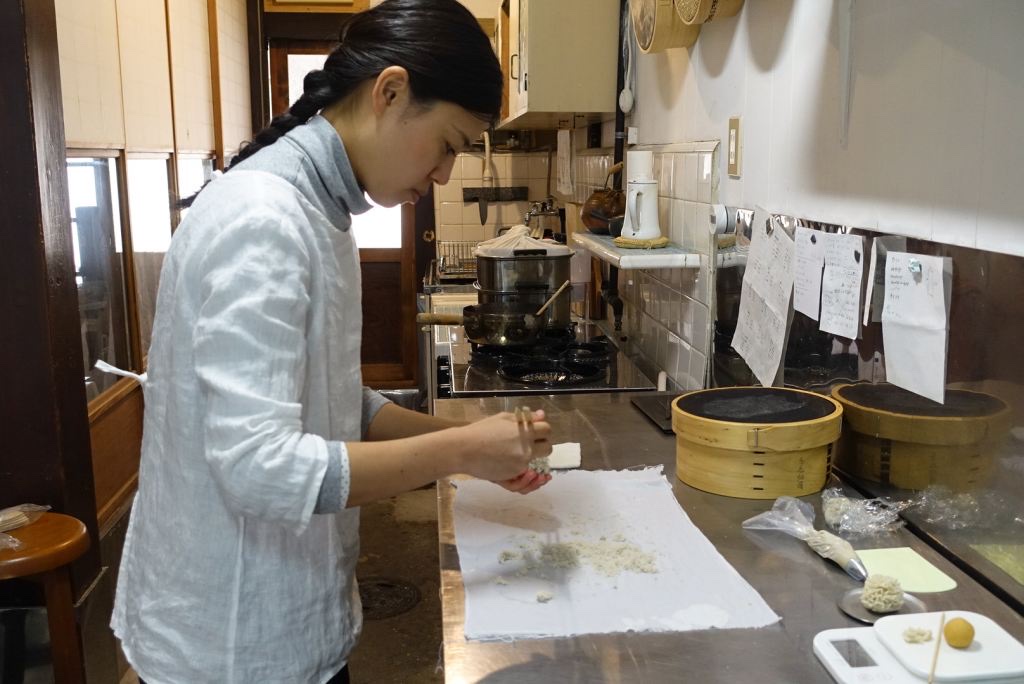
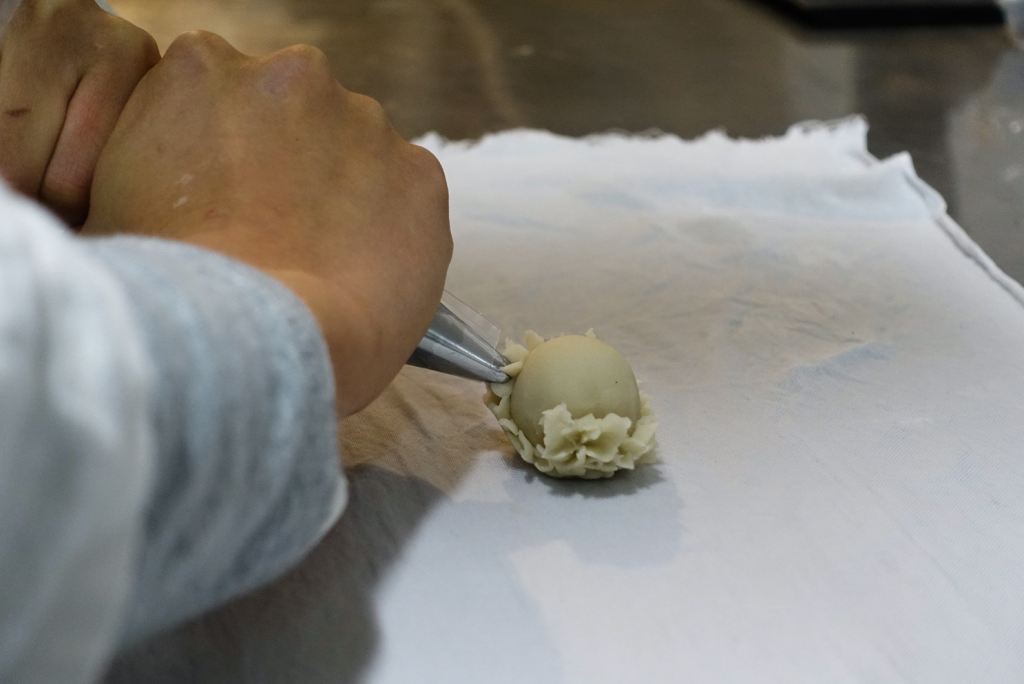
R:2006年,你跟堀部美奈子組成了「日菓」(Nikka),還出版了名為《日菓の仕事、京の和菓子》的作品集。我是從那本書開始認識日菓的,也是那書改變了我對和菓子的印象。日菓的新派和菓子充滿故事性,像造成Tetris方塊形狀的菓子,還有名為「三時」的菓子,圓形缺了右上方的四分一塊,像徵了時間。但到2016年,日菓備受大眾注目的時候,你們卻決定解散,是因為甚麼原因呢?
S:我跟堀部小姐是在和菓子店工作時認識的,那時大家的想法很相近,希望透過和菓子作為媒介,傳達某種世界觀,於是便決定一起實踐。當時的目標是出一本書、辦一個展覽,後來目標全都達成了。而且我想做的事卻有了一些轉變,感覺上即使日菓也繼續下去,我們也很難前進。另一方面,也因為我們各自結婚,能一起工作的時間變少了,所以才決定解散各自發展的,我便成立了御菓子丸(Okashi Maru)。
R:想做的事轉變了,是指怎樣的轉變呢?
S:日菓很注意和菓子背後的故事,不過很多時故事跟味道是沒有連結的。嗯……例如一個木屐形狀的和菓子,沒有人知道木屐的味道吧(笑),那菓子其實就是羊羹。我很想做到外形與味道、口感相連,例如這個名為「風跡」的菓子,象徵著風的痕跡,味道也是淡泊的,單純以砂糖造成,放進口裡時會立刻化開,就像吃下一口風般。
現今大部份和菓子的製作,都很理所當然地用上食用色素,以凸顯季節色彩。在未有人工食用色素以前,和菓子師會從蔬菜水果中提煉出各種色澤,而古代的和菓子,是純粹將水果風乾之後造成的,是全天然的。提煉色澤的過程非常複雜,已在我的能力範圍以外了,不過我仍希望使用全天然的材料,想要紫色的話,就用紫薯,想要點黃色的話,就添點檸檬,希望讓和菓子的顏色與味道一致。
R: Together with Minako Horrible, you founded Nikka in 2006. You also published Making wagashi, Wagashi in Kyoto. Through this book I learnt about Nikka, as well as a different face of wagashi. The creative wagashi as created by Nikka are always fascinating: wagashi in the shape of Tetris tile, as well as the “Three Time” wagashi in the shape of three-quarter circle that symbolizes time… The two of you decided to go on separate paths in 2016, when Nikka was in the limelight. What was the reason behind?
S: 堀部 and I got to know each other through working in a wagashi store. We had a shared aspiration of expressing our worldview through wagashi. With this belief, we decided to work together in publishing a book and holding an exhibition. Together, we accomplished all the set goals. However, I have changed at some point. I started to think being confined by Nikka could be a hindrance for the two of us to grow further. We also had less time working together after we both got married. Therefore. we decided to work separately, and I founded Okashi Maru after our split.
R: How did you change back then?
S: Stories behind each piece of wagashi were the heart of Nikka, but these stories were sometimes detached from the actual taste. For instance, we made a piece of clog-shaped wagashi, but I guess no one has ever tasted a clog. To be honest it was only a piece of yōkan (azuki-bean jelly). Therefore, I wish to reconnect the shape with the taste and texture. This piece is called “Traces of Wind”. To actualize the metaphor, the mellow taste is created purely by sugar. It instantly melts in your mouth like wind passing without trace.
Most of the modern wagashi use edible pigment to bring out the colour of different seasons. Before artificial edible pigment was introduced to the industry, wagashi makers extracted colour from vegetables and fruits to beautify the delicacy. Wagashi in ancient times were merely all-natural pieces of dried fruit. Colour-extraction is an extremely complicated technique that is unfortunately beyond my ability. To preserve the naturalness, I avoid using any artificial additive: purple potato for the purple color, lemon for the yellow color — color and taste can therefore be in harmony.
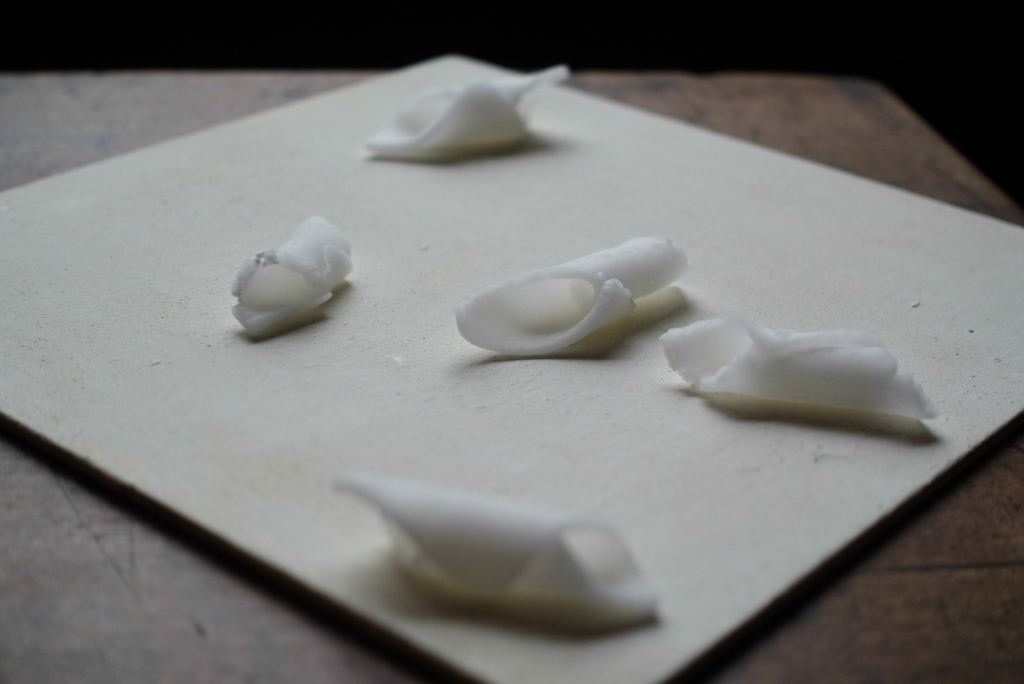
R:外形、味道、口感需同時與主題相連,顏色與味道一致,那構思新作時,會感到很多限制吧?
S:的確是這樣呢,而且還得顧及味道,不好吃不行啊。
R:有一點我很好奇的,御菓子丸的理念及表現手法跟一般的很不同,當你想跟別人討論自己的創作時,會很難找到對象嗎?
S:我也會跟其他和菓子師討論的,談和菓子是一件很快樂的事。不過比起和菓子師,可能跟陶藝家、藝術家,或者說,想透過某些媒介來傳達自己心中想法的人討論會更合適呢。
R:御菓子丸有甚麼未來計劃呢?
S:我想開一家商店,賣自己製作的和菓子,就進家門後的走道中,小小的空間,自己獨自就能打理的。
R: It can be quite a challenge to insist on coordinating among shape, colour, taste, texture, the theme?
S: That’s true, and my wagashi have to be tasty too.
R: The rationale and presentation of Okashi Maru is considerably distinctive from the common practice. Do you find it difficult to find a good listener to discuss about your work?
S: Wagashi is an undeniably interesting topic to talk about. I do sometimes converse with other wagashi makers, but potters and artists may understand me better. After all, we are similar people using different media to express our beliefs.
R: What is the next step for Okashi Maru?
S: I want to have my own shop selling the wagashi I made. Perhaps a small space like the hallway right behind a residential entry door, which I can easily manage on my own.
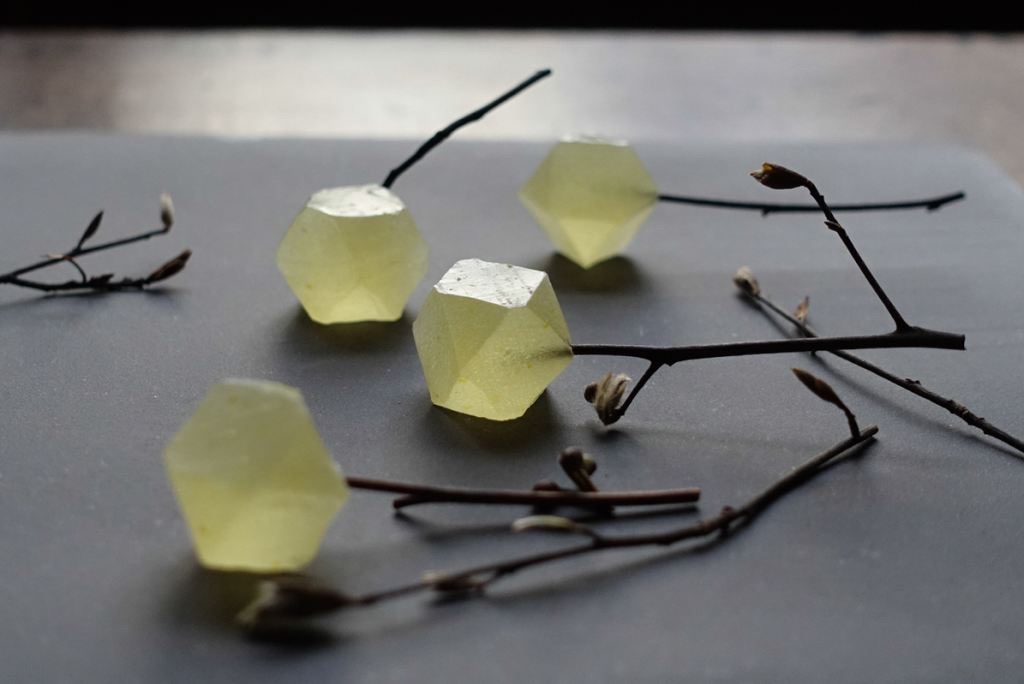
「鉱石の実」,鑛石之實。鑛石的天然而美麗形態,讓杉山早陽子聯想到人類在進行創作之初,大概都是在模仿自然。這個鑛石之實,也是她模擬天然鑛石而創作的。以烏樟樹的枝叉著的黃色菓子,漂亮如寶石,表面裹以脆薄的砂糖,內裡則是柚子寒天,放進口裡,牙齒如履薄冰上,一下陷便掉進柚子浴,好一個冬季。
“The Truth of an Ore”. The naturally beautiful shape of ore reminds Shugiyama of how human creates. The nature is the basis of every human creation, Shugiyama also created by taking root of the forms of ores from mother nature. The yellow wagashi is supported by a Camphor branch, the beautiful image is comparable to a gem. A yuzu agar is coated with a thin crunchy layer of sugar. Cutting through the thin icing, your tongue will then be embraced by the aroma of yuzu. Such a beautiful imagery of winter.
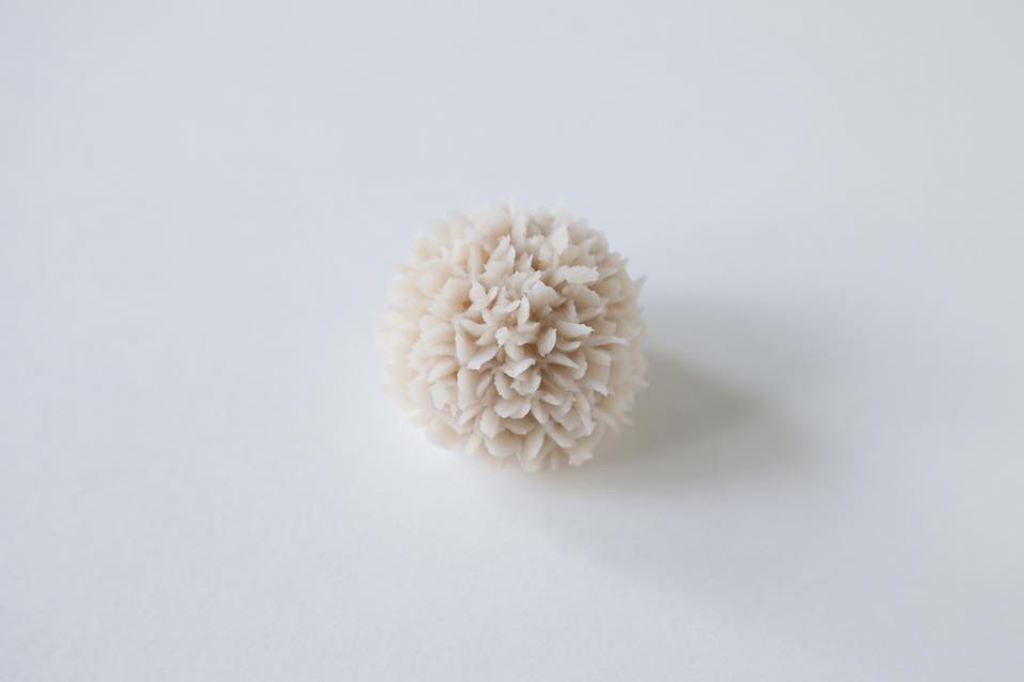
「種子」。這個如同長著絨毛的圓球,仿照著浦公英的外形造成,種子在嘴裡散開,漾出溫暖的五月。
“Seeds”. The felt-like ball mimics the form of dandelion. The seeds scatter in the mouth, and bring out the warmth of May.
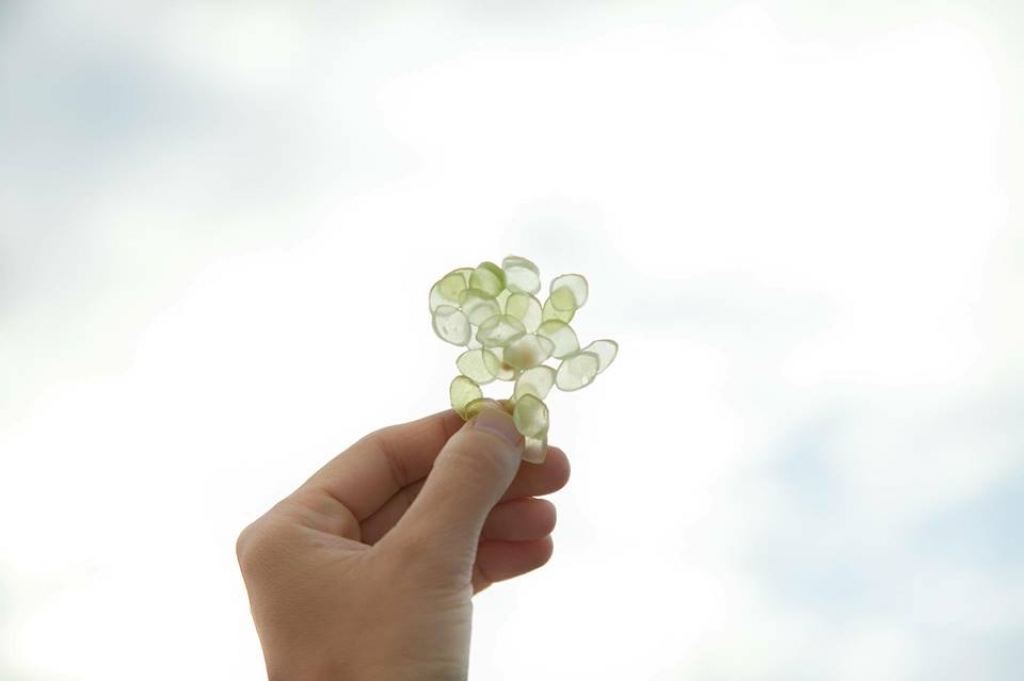
「木漏れ日」,木漏日。天高氣爽的日子,漫步森林內,抬首抑望,驟見閃閃爍爍,陽光自葉片間漏下來,是為「木漏れ日」。
“Sunshine Seeping through Foliage”. Walking in the wood under a clear sky, sunshine seeps in between leaves and creates soothing flickers.
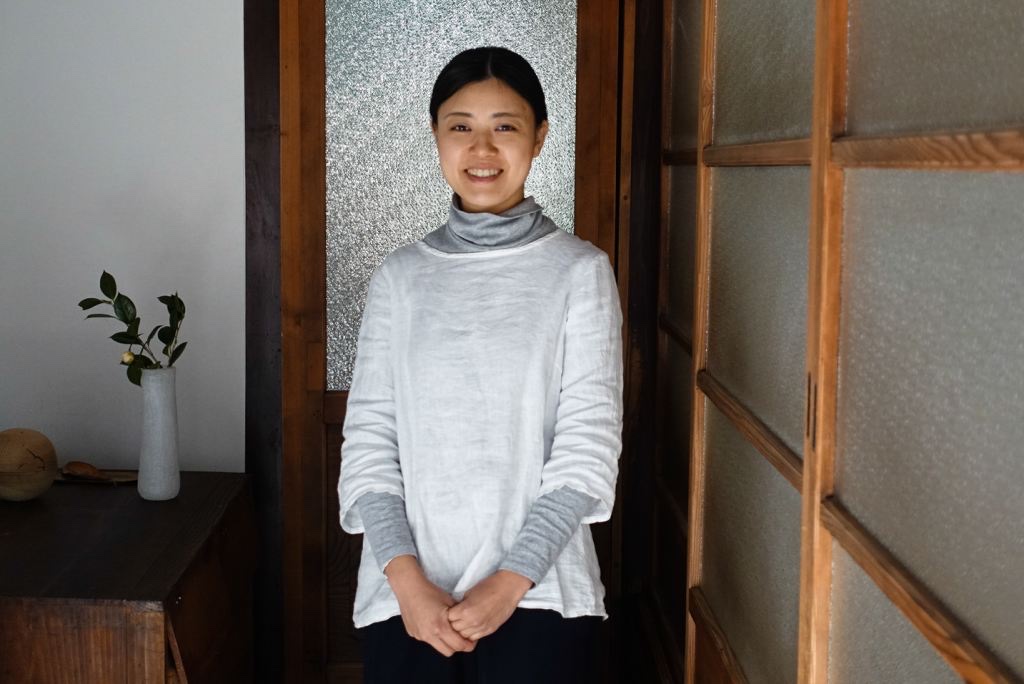
杉山早陽子
1983年生於日本三重縣伊勢市。大學時對和菓子產生興趣,後往和菓子老舖就職,並自學製作。2006年成立「日菓」,2014年拆伙後獨自創辦了「御菓子丸」。其菓子作品於京都市內的咖啡店「木と根」(Kitone)發售。
Sayoko Shugiyama
Born in Ise, Mie Prefecture in 1983. Shugiyama became interested in wagashi when studying in university. She once worked in wagashi stores, and is a self-taught wagashi maker. Shugiyama founded Nikka in 2006, and started Okashi Maru after splitting with her partner from Nikka. Her wagashi are sold in Kitone, a coffee shop in Kyoto.
